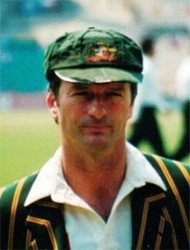Steve Waugh has advised England to emulate New Zealand in order to rejuvenate their cricket “on and off the pitch”.
Even given the obvious differences, cultural and otherwise, between cricketing nations on opposite sides of the planet, Waugh’s use of New Zealand as a template is as relevant to the West Indies in several areas as it is to England.
Waugh went back three years when, he said, New Zealand “seemed to be in real strife”.
 “People were saying they’re not competitive in Test cricket and just okay in one-day cricket,” he recalled.
“People were saying they’re not competitive in Test cricket and just okay in one-day cricket,” he recalled.
They were comfortably beaten in both Tests, four of the five ODIs and both Twenty20s in the West Indies in 2012. Six months later they were skittled for 45 in the first of two Tests in South Africa, both of which they lost by an innings.
Since then, New Zealand has emerged from their trough to become tough, no longer underrated, opponents. The outcomes of their six Tests, home and away, against the West Indies over the past year and a half are 4-1 in their favour.
They have prevailed over India and Sri Lanka and came within a wicket of claiming the series against England at home and have shared two Tests with Pakistan in the United Arab Emirates, an alien venue.
With players’ strikes and board’s blunders, West Indies cricket has been similarly “in real strife”, now for the better part of two decades
Even if India shelves its implausible claim for US$42 million compensation for the team’s early exit from their scheduled tour last year, as is now reportedly likely, the West Indies Cricket Board (WICB) is still basically bankrupt; according to its annual financial statement, compiled by international auditing firm KPMG, there is “significant doubt over the Board’s ability to continue as a going concern”.

It has now had to agree to a joint management deal with Caricom, an organization itself not renowned for its cohesion.
A cursory glance at the results explains why “people” have stated the irrefutable, that they haven’t been competitive in Test cricket and “just okay” in ODIs. It is only in the newest, shortest form of the game, the Twenty20, that they are a force.
Even if the signs of a new spirit are evident in their fightbacks against England in the current series, unlike New Zealand, they are yet to make any significant advances.
So what does Waugh identify as the main sparks for New Zealand’s resurgence – and how do they relate to the West Indies?
Primarily, it is the new, refreshing attitude to the way they play the game and a significant improvement in the quality of their pitches.
The former Australian captain attributed their changed outlook on the field to Brendon McCullum, captain since 2013, “a really good positive leader who has encouraged the players to play their natural way and not be scared of failure”.
He noted that the pitches are much quicker and bouncier that they used to be, stimulating “fast bowlers and stroke-play” and contributing to “much better cricket”.
Leaders such as McCullum are rare, especially for New Zealand whose cricket was always perceived as dull and unadventurous. It is one claim that could not be made against the West Indies but, after 15 years global dominance, the old taunt of ‘Calypso Collapso’ has increasingly returned. The ultimate slight was the incoming head of the England board’s comment prior to the current series that the team is “mediocre”.
They are yet to find a captain or coach who has been able to coax their charges to play “their natural way and not be scared of failure”. Pessimism has become ingrained by the record of defeats.
Perhaps the new head coach, Phil Simmons, can bring about change. He did wonders during his eight years with Ireland; back home, he faces an exacting challenge. It is far too early to judge

whether he can trigger a turnaround yet his two Tests in charge are promising.
The most pressing cricketing issue among a host of others is pitches, both at regional and international level.
For several years, they have confined spinners to an unfair and damaging extent. Of the top 10 leading wicket-takers in the 2014-15 Caribbean Professional League eight were spinners.
The returns in the two matches played at the grounds used in the England series are instructive.
At the National Stadium in Grenada, off-spinner Liam Sebastien, an average off-spinner, had five wickets in each innings, left-arm Alston Bobb four in the first for the Windwards against the Leewards.
In the return match at the Antigua Recreation Ground, off-spinner Rahkeem Cornwall, the big Antiguan, returned seven for 97 the Windwards innings; Verasammy Permaul and Davendra Bishoo responded with nine between them. Shivnarine Chanderpaul is said to have predicted that if the Test pitch was as spiteful, the match again be abandoned, as it was in 2009 for its beach of an outfield.
The West Indies and England found entirely different surfaces for the Tests. Prepared under the supervision of the WICB’s pitch supervisor, Kent Crafton, they were flat, slow and featureless, from the ridiculous to the sublime. Bishoo, the little leg-spinner, took 61 wickets at 17 runs each in the CPL; in his first Test in four years at the Grenada National Stadium, he laboured 51 overs for four wickets for 177 runs. It was equally exacting on bowlers of all types on both sides.
Neither way can West Indies cricket return to anything near its best. New Zealand have succeeded in making sure their pitches are much quicker and bouncier that they used to be, stimulating “fast bowlers and stroke-play” and contributing to “much better cricket”.
The same should not be beyond the capacity of the West Indies.




